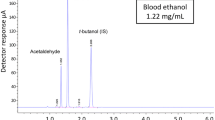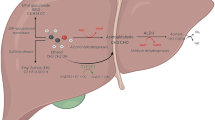Abstract
Iso-α-acids (IAA) and reduced IAA can be used as beer-specific ingredient congeners to confirm beer consumption when detected in blood and other specimens using a UHPLC–MS/MS method. Recent analysis of postmortem casework demonstrated a high prevalence of beer consumption and the possibility of providing the source of alcohol in forensic casework. Research outlined in this manuscript has examined the degree to which the interval after death and quality of blood affects the concentration of IAA in postmortem cases. Postmortem whole blood and serum were analyzed in cases where natural or reduced IAA groups were detected. The trans-IAA, cis-IAA, and tetrahydro-IAA (TIAA) groups were subject to postmortem redistribution, although only weakly associated with the length of time from death to collection of specimens. Serum had threefold higher concentrations than blood for trans-IAA, cis-IAA, and TIAA. These studies confirm that although postmortem concentrations cannot be easily compared to concentrations found in living persons the presented findings do provide some understanding to assist in interpretation where the confirmation of beer consumption is required in forensic casework.

Similar content being viewed by others
References
Global status report on alcohol and health. Switzerland: World Health Organization; 2011.
Pilgrim JL, Gerostamoulos D, Drummer OH. “King hit” fatalities in Australia, 2000–2012: the role of alcohol and other drugs. Drug Alcohol Depend. 2014;135:119–32.
Australian Bureau of Statistics. 4307.0.55.001—apparent consumption of alcohol, Australia, 2012–13. 2014. www.abs.gov.au/ausstats/abs@.nsf/Lookup/4307.0.55.001main+features12012-13. Accessed May 2014.
Nelson M. The Barbarian’s beverage: a history of beer in ancient Europe. New York: Taylor & Francis e-Library; 2005.
Rodda LN, Gerostamoulos D, Drummer OH. The rapid identification and quantification of Iso-α-acids and reduced Iso-α-acids in blood using UHPLC-MS/MS: validation of a novel marker for beer consumption. Anal Bioanal Chem. 2013;405(30):9755–67.
Rodda LN, Gerostamoulos D, Drummer OH. The stability of Iso-α-acids and reduced Iso-α-acids in stored blood specimens. Forensic Sci Int. 2014;239:44–9.
Rodda LN, Gerostamoulos D, Drummer OH. Pharmacokinetics of Iso-α-acids in volunteers following the consumption of beer. J Anal Toxicol. 2014;38:354–9.
Rodda LN, Gerostamoulos D, Drummer OH. Pharmacokinetics of reduced Iso-α-acids in volunteers following clear bottled beer consumption (accepted). Forensic Sci Int. 2014.
Rodda LN, Gerostamoulos D, Drummer OH. Detection of Iso-α-Acids to confirm beer consumption in postmortem specimens (under Review). Drug Test Anal. 2014.
Annual Alcohol Poll: Attitudes and behaviours. Australian Capital Territory, Australia: Foundation for Alcohol Research and Education (FARE); 2014.
Byrnes JM, Doran CM, Shakeshaft AP. Cost per incident of alcohol-related crime in New South Wales. Drug Alcohol Rev. 2012;31(7):854–60.
Collins DJ, Lapsley HM. The costs of tobacco, alcohol and illicit drug abuse to Australian society in 2004–05. Canberra: Commonwealth of Australia; 2008.
Drummer O, Forrest AR, Goldberger B, Karch SB. Forensic science in the dock. BMJ. 2004;329(7467):636–7.
Rodda KE, Drummer OH. The redistribution of selected psychiatric drugs in post-mortem cases. Forensic Sci Int. 2006;164(2–3):235–9.
McIntyre IM. Identification of a postmortem redistribution factor (F) for forensic toxicology. J Anal Sci Tech. 2014;5(24):1–3.
Pounder DJ, Jones GR. Post-mortem drug redistribution—a toxicological nightmare. Forensic Sci Int. 1990;45(3):253–63.
Prouty RW, Anderson WH. The forensic science implications of site and temporal influences on postmortem blood-drug concentrations. J Forensic Sci. 1990;35(2):243–70.
Robertson MD, Drummer OH. Postmortem distribution and redistribution of nitrobenzodiazepines in man. J Forensic Sci. 1998;43(1):9–13.
Gerostamoulos D, Beyer J, Staikos V, Tayler P, Woodford N, Drummer OH. The effect of the postmortem interval on the redistribution of drugs: a comparison of mortuary admission and autopsy blood specimens. Forensic Sci Med Pathol. 2012;8(4):373–9.
Skopp G. Preanalytic aspects in postmortem toxicology. Forensic Sci Int. 2004;142(2–3):75–100.
Saar E, Beyer J, Gerostamoulos D, Drummer OH. The time-dependant post-mortem redistribution of antipsychotic drugs. Forensic Sci Int. 2012;222(1–3):223–7.
Flanagan RJ, Connally G. Interpretation of analytical toxicology results in life and at postmortem. Toxicol Rev. 2005;24(1):51–62.
Drummer OH. Post-mortem toxicology. Forensic Sci Int. 2007;165(2–3):199–203.
Butzbach DM. The influence of putrefaction and sample storage on post-mortem toxicology results. Forensic Sci Med Pathol. 2010;6(1):35–45.
Carroll FT, Marraccini JV, Lewis S, Wright W. Morphine-3-D glucuronide stability in postmortem specimens exposed to bacterial enzymatic hydrolysis. Am J Forensic Med Pathol. 2000;21(4):323–9.
Martinez-Ramirez JA, Walther G, Peters FT. Studies on drug metabolism by fungi colonizing decomposing human cadavers. Part II: biotransformation of five model drugs by fungi isolated from post-mortem material. Drug Test Anal. 2014; doi:10.1002/dta.1669.
Robertson MD, Drummer OH. Postmortem drug metabolism by bacteria. J Forensic Sci. 1995;40(3):382–6.
Kennedy MC. Post-mortem drug concentrations. Intern Med J. 2010;40(3):183–7.
Hilberg T, Rogde S, Morland J. Postmortem drug redistribution-human cases related to results in experimental animals. J Forensic Sci. 1999;44(1):3–9.
Yarema MC, Becker CE. Key concepts in postmortem drug redistribution. Clin Toxicol. 2005;43(4):235–41.
Demir-Kavuk O, Bentzien J, Muegge I, Knapp EW. DemQSAR: predicting human volume of distribution and clearance of drugs. J Comput Aided Mol Des. 2011;25(12):1121–33.
ChemAxon MarvinSketch. 6.3.1,201. 2014. www.chemaxon.com.
Viswanadhan VN, Ghose AK, Revankar GR, Robins RK. Atomic physicochemical parameters for three dimensional structure directed quantitative structure-activity relationships. 4. Additional parameters for hydrophobic and dispersive interactions and their application for an automated superposition of certain naturally occurring nucleoside antibiotics. J Chem Inf Comput Sci. 1989;29(3):163–72.
Klopman G, Li J-Y, Wang S, Dimayuga M. Computer automated log P calculations based on an extended group contribution approach. J Chem Inf Comput Sci. 1994;34(4):752–81.
Cattoor KO, Bracke M, Deforce D, De Keukeleire D, Heyerick A. Transport of hop bitter acids across intestinal Caco-2 cell monolayers. J Agric Food Chem. 2010;58(7):4132–40.
Blanco CA, Rojas A, Nimubona D. Effects of acidity and molecular size on bacteriostatic properties of beer hop derivates. Trends Food Sci Technol. 2007;18(3):144–9.
Kappler S, Schönberger C, Krottenthaler M, Becker T. Isohumulones—a review. Brew Sci. 2010;63:105–11.
Skopp G, Potsch L, Ganssmann B, Aderjan R, Mattern R. A preliminary study on the distribution of morphine and its glucuronides in the subcompartments of blood. J Anal Toxicol. 1998;22(4):261–4.
Skopp G, Potsch L, Mauden M, Richter B. Partition coefficient, blood to plasma ratio, protein binding and short-term stability of 11-nor-delta(9)-carboxy tetrahydrocannabinol glucuronide. Forensic Sci Int. 2002;126(1):17–23.
Drummer OH. Pharmacokinetics and metabolism. In: Moffat AC, Osselton MD, Widdop B, Watts J, editors. Clarke’s analysis of drugs and poisons. 4th ed. London: Pharmaceutical Press; 2010.
Acknowledgments
The authors would like to acknowledge Mr Gavin Reichel in obtaining the mortality data and the assistance of forensic pathologists, mortuary technicians, and toxicologists at the Victorian Institute of Forensic Medicine.
Author information
Authors and Affiliations
Corresponding author
Rights and permissions
About this article
Cite this article
Rodda, L.N., Gerostamoulos, D. & Drummer, O.H. The postmortem redistribution of iso-α-acids in postmortem specimens. Forensic Sci Med Pathol 10, 550–556 (2014). https://doi.org/10.1007/s12024-014-9609-9
Accepted:
Published:
Issue Date:
DOI: https://doi.org/10.1007/s12024-014-9609-9




